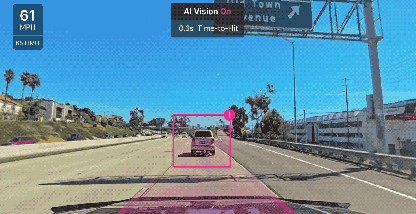Dash cam footage not only provides evidence of what happens on the road, but it can also enable safety managers to identify at-risk drivers with poor driving habits. By combining road-facing dash cams with a feature-rich fleet management software, fleets can significantly improve their driver coaching programs.
Dashboard cameras provide numerous benefits for commercial fleets. They protect drivers from false claims when accidents occur. The video footage is also an effective teaching tool for you to use with drivers.
Here are 5 tips to help you facilitate more effective driver coaching programs with the help of dash cams.
1. Make training more effective with personalized coaching programs
Video footage allows you to identify at-risk drivers and their unsafe driving practices. With the help of dash cam footage and advanced safety features, you can easily pinpoint which drivers need to learn and then customize their fleet safety programs accordingly.
Videos recorded by dash cams show you everything before, during, and after a safety event, allowing them a clear view of the specific factors that may have contributed to the driver’s decisions behind the wheel.
These factors can either be internal or external. An internal factor, for example, is the driver’s temperament or fatigue, whereas an external factor could be an unexpected road hazard. Regardless, you can teach drivers how to avoid them.
By personalizing driver coaching programs, you can make them more effective and productive. Motive customers can also use the Driver Coaching feature to easily manage all safety events and coaching statuses in one place.
2. Use accident videos as examples
Using video footage, you can pinpoint mistakes, explain the poor decision-making behind them, and instruct drivers on what should have been done instead.
0:10
Talking about this Smart Dashcam footage, Motive’s safety expert, Chris Hanie, said that although the driver did most of the things right, “they could have worked a little harder to give that truck space to move over.” Apart from the safety tip, this video perfectly captures the other driver’s fault. This Smart Dashcam footage can be used to exonerate the driver. Without video evidence, it would have been their words against yours.
3. Cultivate a culture of safety by getting drivers on board
Remember to be transparent about the use of dash cams with your drivers. You need every member of your team to agree to any fleet safety program involving dash cams for it to be successful.
Just like with accident videos, you can more clearly demonstrate positive driving habits with video footage. Ask your veteran drivers to install dash cams first and get their opinions. Then ask them to share their experiences with fellow drivers who may not be as familiar with dash cams.
Norman Bright, a fleet and safety manager for Woodford Oil, recently oversaw the implementation of Motive Smart Dashcams in all 50 vehicles. He introduced the Smart Dashcam to a veteran driver first and asked him to share his experience with the rest of the team.
“Everyone was then accepting of the forward-facing cameras (in their truck),” Bright says.
Your drivers will be more likely to agree to dashcam usage if they know that it’s primarily for their safety and exoneration.
“The selling point we used with our drivers was ‘it’s going to be to their benefit’,” told Norman Bright. “Once our drivers realized the dash cam’s benefits, they accepted them.”
4. Work with drivers to set safety event triggers
Critical safety events, such as excessive acceleration, hard braking, and hard cornering, trigger dash cams to record video footage. When you work cooperatively with drivers to set them up, they are more likely to respond to the driver training campaign, learn, and correct their mistakes.
To make sure everyone is on the same page, work with drivers to set thresholds for safety events. The Motive platform allows you to easily customize safety event triggers.
5. Set goals, monitor them, and provide regular feedback
Once dash cams are installed, performance assessment is extremely important. After setting goals, you should regularly monitor driver performance and safety scores and follow-up with feedback. This can help build a culture of continuous improvement.
You can use the Driver Scorecards, which ranks the worst- and best-performing drivers for you.
Use that data to optimize your fleet safety program by creating rewards and incentives for the safest drivers. Incentives and encouragement can motivate drivers and improve your business’ overall level of fleet safety and help with driver retention.
Key takeaways
Paired with fleet management systems that assess driver behavior, dash cams can be instrumental in creating a culture of safety.
With the Smart Dashcam, you may be able to get better insurance rates, improve your drivers’ CSA scores, and obtain evidence in case of road accidents.
With the strategies listed above, dash cams can also become an integral aspect of driver training.
If you have any questions, call (844) 257 6396 or email at smartdashcam@gomotive.com.









